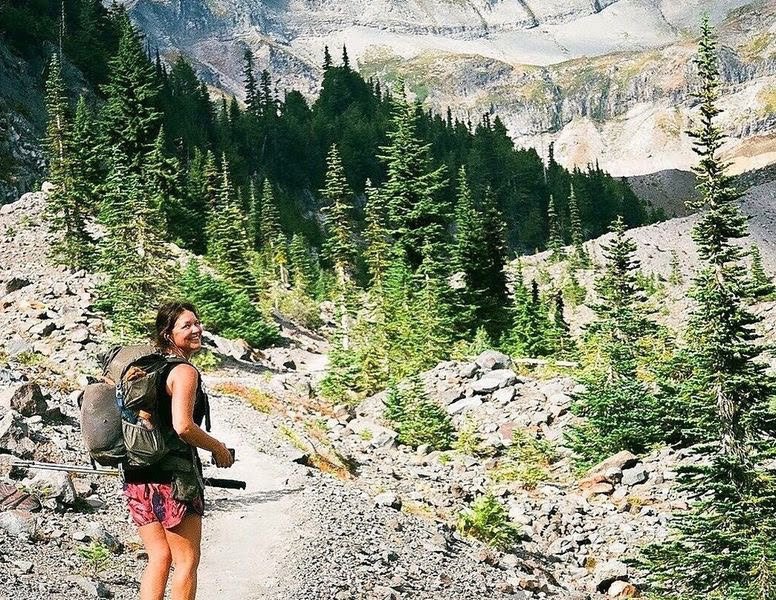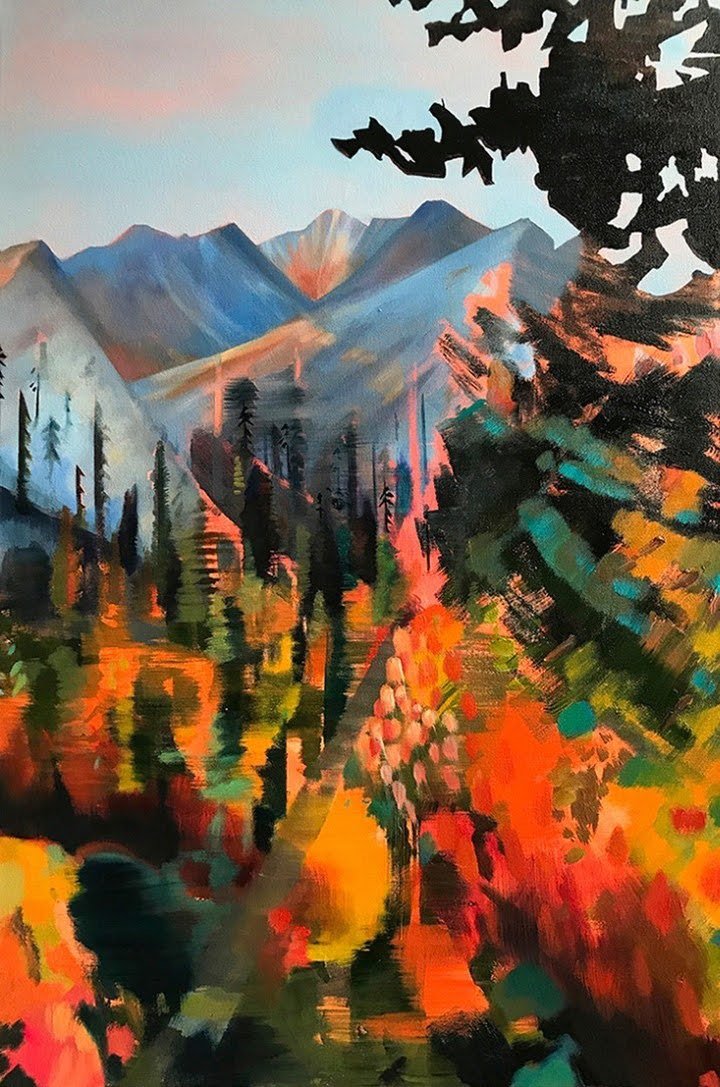Spotlight on Annie Varnot
/BY CARA SCHAEFER
While it’s impossible to capture the beauty of the natural world in one image, some of artist Annie Varnot’s paintings come pretty close. We spoke with her about backpacking the Pacific Crest Trail, the emotions that come with a thru-hike, and how art has influenced her perspective on nature.
Art photos courtesy of Annie Varnot.
OUT THERE: How did nature become a focal point of your art?
ANNIE VARNOT: It essentially became a focal point when I moved to New York City, and my environment lacked anything that was natural, besides myself and other humans. It was very gray and gridded, and I immediately started getting panic attacks. I didn't realize that I would have such a severe reaction to the city, coming from a rural upbringing living off the land.
And it was at the same time when things like cell phone towers were being made to look like trees, and there was this odd feeling in the world, for me, about our relationship to nature. So I started making drinking straw sculptures in my studio with repurposed materials. At first, it was me going out and hunting trash — straws, things like that. I made these organisms and landscapes that I would illuminate on custom light tables, or pedestals, and I would work through my concern about the environment, and optics, and ethics in the ocean. I was asking the question, can you take non-natural materials and mimic or reference nature, and get the property of nature from that? In the end, that didn't give me the benefits I seek from nature , but that’s how I started.
OT: Can you describe an experience that you had while hiking that later appeared in your work?
AV: I was working with the drinking straw sculptures for quite a long time, though I wasn’t making as much artwork as I wanted, since I was trying to make a living in New York City. Around that time I had some really traumatic things happen in my life. I was diagnosed with cancer. I got married, and then miscarried in the same year. I got divorced. I was so devastated.
I had a friend who was an artist, and an adventurer too. Her trail name is Wandering Dot, and in 2011 she was attempting the PCT. She asked, “Why don’t you kickstart my hike with me?” She hadn't done anything like this before, and she was nervous. And I was just an emotional dead weight. I was like, ‘Who the hell would want to hike with me?’ I was so depressed. So, we got out there, and we had planned to share all her gear, and it was just so obvious after one night that no, we can’t share a one-person tent. No, we both need our own water filters. I borrowed some gear from a trail angel, Scout.
I had to get off to fulfill my responsibilities at an artist fellowship in Wyoming. I went back to New York City after the residency, and knew I had to get back to trail. I was immediately so immersed in it, and in love with it.
I hadn’t really connected the experience of backpacking with my art yet, but I did start to draw on the half-mile topo maps, and I would cut them up and collage them. I was exploring the iconography that was specific to my experience on the trail, and how it could live within a visual medium. I started to use art, collage, watercolor, and even the drinking straws, to get more specific and learn more about actual places, versus general places. I started to make maps of my day on the PCT with hints to locations, or the parts of the trail, and then some sort of language, like the keys that maps have. I tend to gravitate more towards the emotional aspect of the experience and being in a place. And also all of the different aspects of experiencing the trail while moving — more of how I see it, versus how I would see it through a camera lens.
Photo courtesy of Jennifer Gift.
OT: What does long distance hiking feel like for you?
AV: I feel, ironically, so connected. In New York City, amongst all of the people, I feel very alone. When I'm in nature, I never feel lonely. I've had these transcendental, spiritual experiences being out on the trail, the first happening on the Pacific Crest Trail which was my first thru-hike. I had this moment where I had been hiking solo for quite some time, so I wasn't thinking in a verbal language. I had this complete boundaryless experience, where everything was connected. I was both miniscule, but also important. I had read about this egoless experience, but I had never experienced it. Just trying to recollect that moment makes me teary. It felt as if I finally understood my existence on the planet, and I didn't really need to do anything to have purpose.
And then getting off of the trail, when you re-enter civilization, there is an extreme counter observation of materialism. On the trail, I didn't have a mirror. I could have had all kinds of shit going on on my face. And it didn't matter. Everybody who was on the trail around you embraced that, and it didn't matter at all. Getting back, I felt the extreme level of consumerism and materialism. The reflection of a mirror in other people's faces and feeling judged — like there was something wrong with me because I didn't look like them. All of that becomes internalized as, ‘I need to be a certain way to be valued in society.’
The overall feeling of being on trail is this ultimate freedom in surrendering all of the weight that we impose on ourselves while in civilization. We're so overwhelmed with all of these tasks we need to do, or the sense that we have these obligations. When you're out on trail, all of that goes away, and there's so much space.
OT: Has creating art influenced the way that you see nature?
AV: When I first went to the Pacific Crest Trail, I didn't have an art project in mind that I wanted to partake in while I was hiking. I wanted to just have the experience of thru-hiking, because thru-hiking is so hard already, and I wanted to be open to whatever came in this place of the unknown. Then towards the end of the Pacific Crest Trail, I had this moment of, ‘This is what I want to talk about. Nature.’ My experience in nature, and how important nature is to us. And what's happening out there, because being out there you experience climate change on a daily level. It affects your hike.
So I thought, let's paint it. When I went back out into nature, I definitely was looking more keenly at form, and subject, and shape. And specificity like, ‘Oh look at the shape of this tree. How is that shape different from this shape?’ I hadn't practiced painting trees ever, so it was just looking, observing, and absorbing from different perspectives — like being up high versus being down low. And the sky, it’s a phenomenal subject! It’s endless. It's just lovely.






